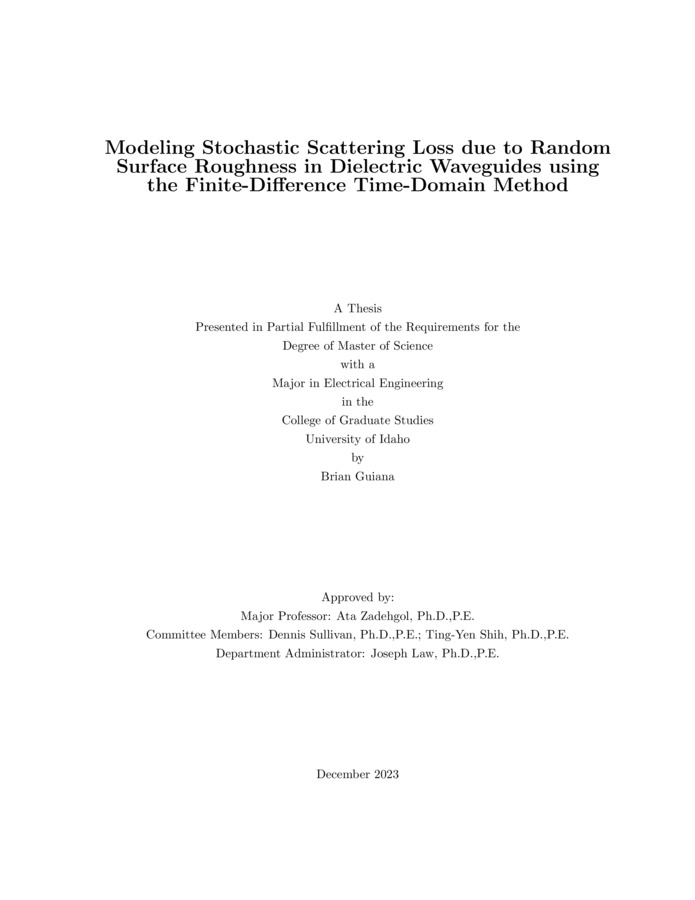Modeling Stochastic Scattering Loss due to Random Surface Roughness in Dielectric Waveguides using the Finite-Difference Time-Domain Method
Guiana, Brian. (2023-12). Modeling Stochastic Scattering Loss due to Random Surface Roughness in Dielectric Waveguides using the Finite-Difference Time-Domain Method. Theses and Dissertations Collection, University of Idaho Library Digital Collections. https://www.lib.uidaho.edu/digital/etd/items/guiana_idaho_0089n_12721.html
- Title:
- Modeling Stochastic Scattering Loss due to Random Surface Roughness in Dielectric Waveguides using the Finite-Difference Time-Domain Method
- Author:
- Guiana, Brian
- Date:
- 2023-12
- Keywords:
- Dielectric Waveguides Optical Interconnects Power Integrity Random Surface Roughness Signal Integrity Silicon-on-Insulator
- Program:
- Electrical and Computer Engineering
- Subject Category:
- Electrical engineering; Electromagnetics; Nanotechnology
- Abstract:
-
The dielectric slab waveguide (DSW) has been the subject of much analysis in the past decades, with many important applications in high-speed high-bandwidth electromagnetic propagation. Electromagnetic (EM) scattering may be a significant source of degradation in signal and power integrity of high-contrast silicon-on-insulator (SOI) nano-scale interconnects, such as opto-electronic or optical interconnects operating at 100s of THz where two-dimensional (2D) analytical models of DSWs are often used to approximate scattering loss. However, nearly all analysis of the DSW’s stochastic propagation loss α (dB/cm), associated with random surface roughness of its sidewalls, has revolved around the transverse-electric (TE) mode of operation. In this work, a formulation is presented to relate the scattering (propagation) loss to the scattering parameters (S-parameters) for the smooth waveguide; the results are correlated with results from the finite-difference time-domain (FDTD) method in 2D and 3D space. We propose a normalization factor to the previous 2D analytical formulation for the stochastic scattering loss based on physical parameters of waveguides exhibiting random surface roughness under the exponential autocorrelation function (ACF), and validate the results by comparing against numerical experiments via the 2D FDTD method, through simulation of hundreds of rough waveguides; additionally, results are compared to other 2D analytical and previous 3D experimental results. The FDTD environment is described and validated by comparing results of the smooth waveguide against analytical solutions for wave impedance, propagation constant, and S-parameters. Results show that the FDTD model is in agreement with the analytical solution for the smooth waveguide and is a reasonable approximation of the stochastic scattering loss for the rough waveguide. This work derives analytical expressions for α in the transverse-magnetic (TM) mode, and correlates it against numerical experiments in the method of finite-difference time-domain (FDTD) in both two-dimensional (2D) and three-dimensional (3D) space using duality. We perform several stochastic numerical experiments using FDTD simulation, and show that α correlates well against the proposed 2D analytical model and 2D FDTD in the range of interest.
- Description:
- masters, M.S., Electrical and Computer Engineering -- University of Idaho - College of Graduate Studies, 2023-12
- Major Professor:
- Zadehgol, Ata
- Committee:
- Sullivan, Dennis; Shih, Ting-Yen; Law, Joseph
- Defense Date:
- 2023-12
- Identifier:
- Guiana_idaho_0089N_12721
- Type:
- Text
- Format Original:
- Format:
- application/pdf
- Rights:
- In Copyright - Educational Use Permitted. For more information, please contact University of Idaho Library Special Collections and Archives Department at libspec@uidaho.edu.
- Standardized Rights:
- http://rightsstatements.org/vocab/InC-EDU/1.0/

